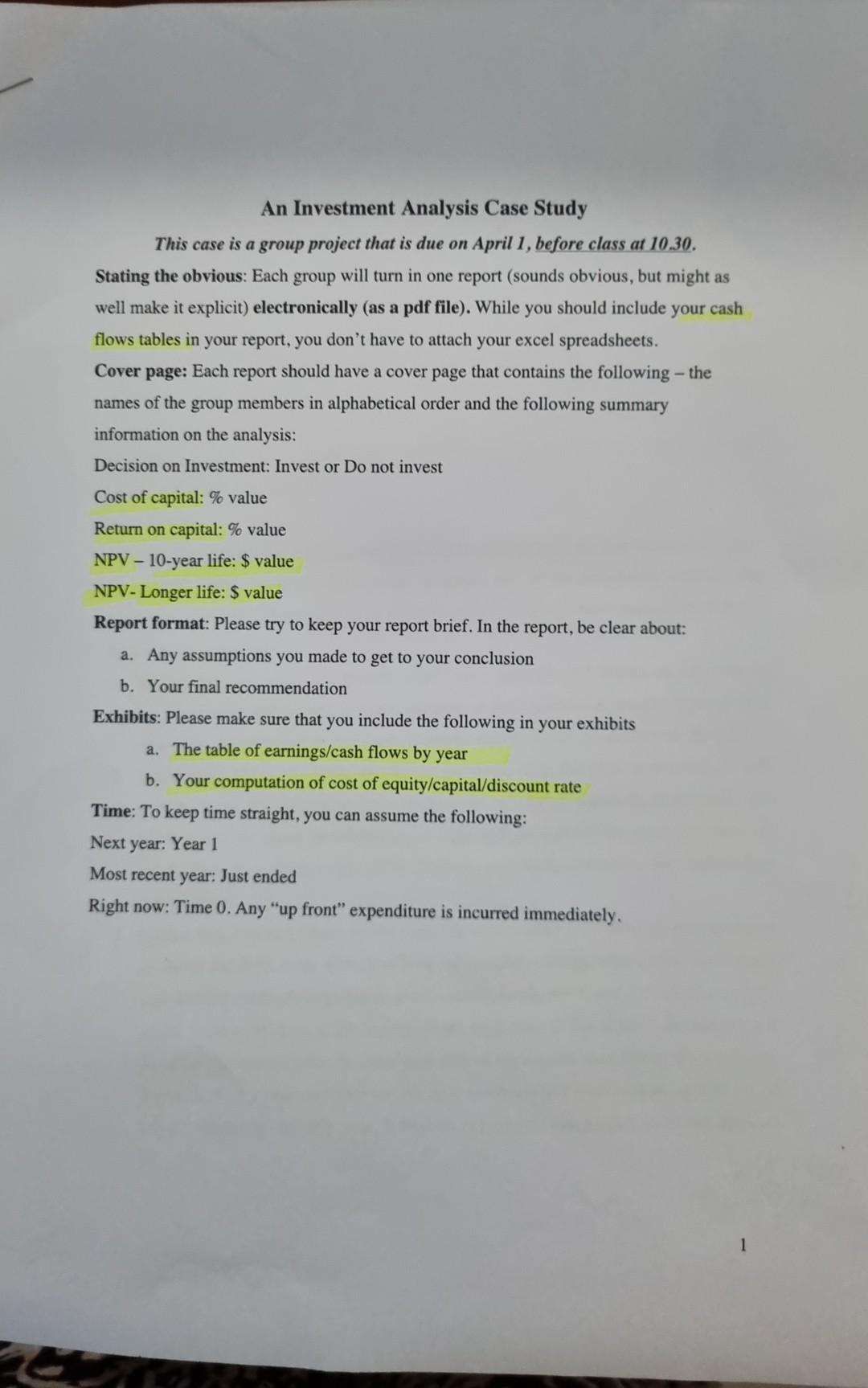
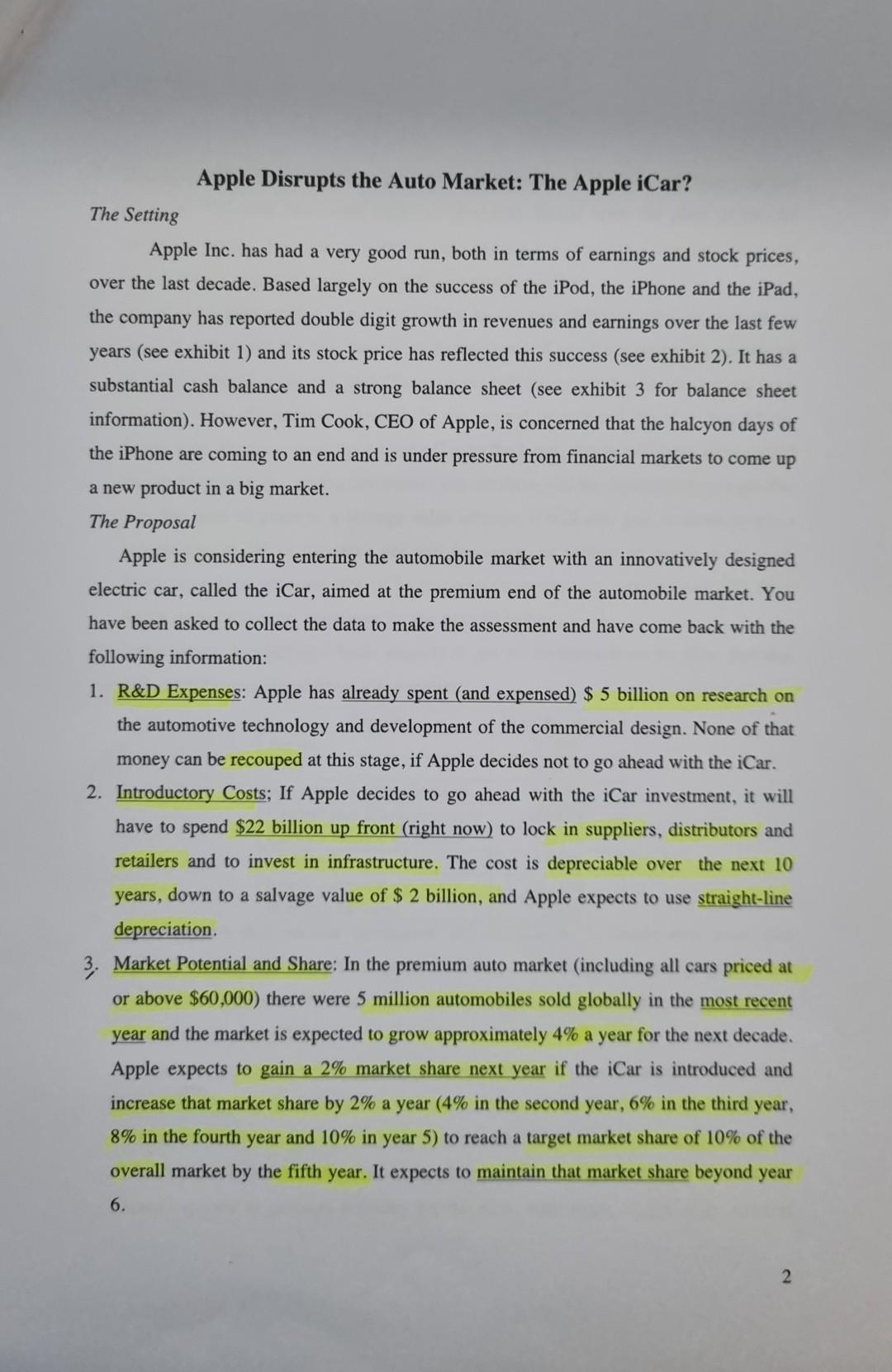


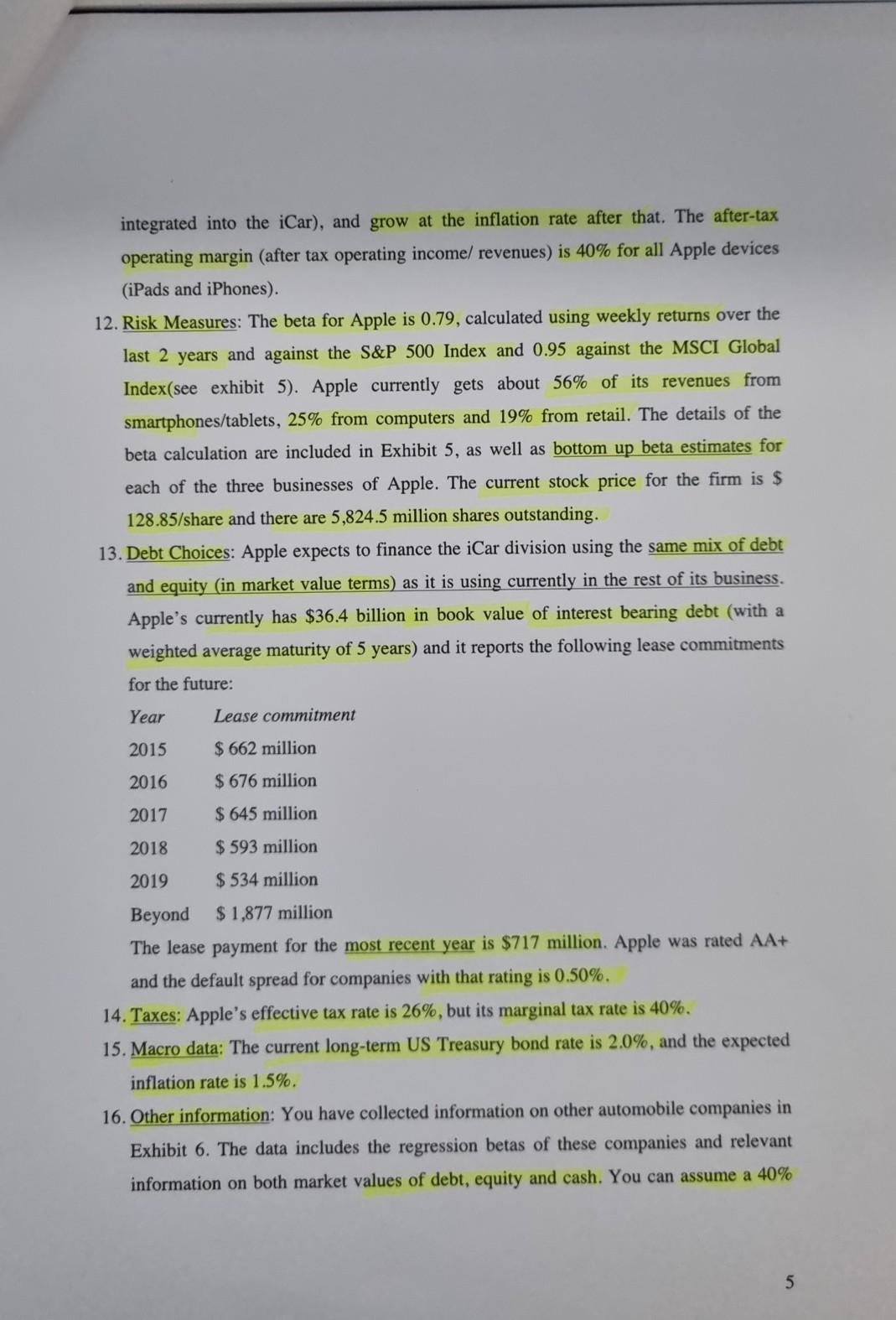
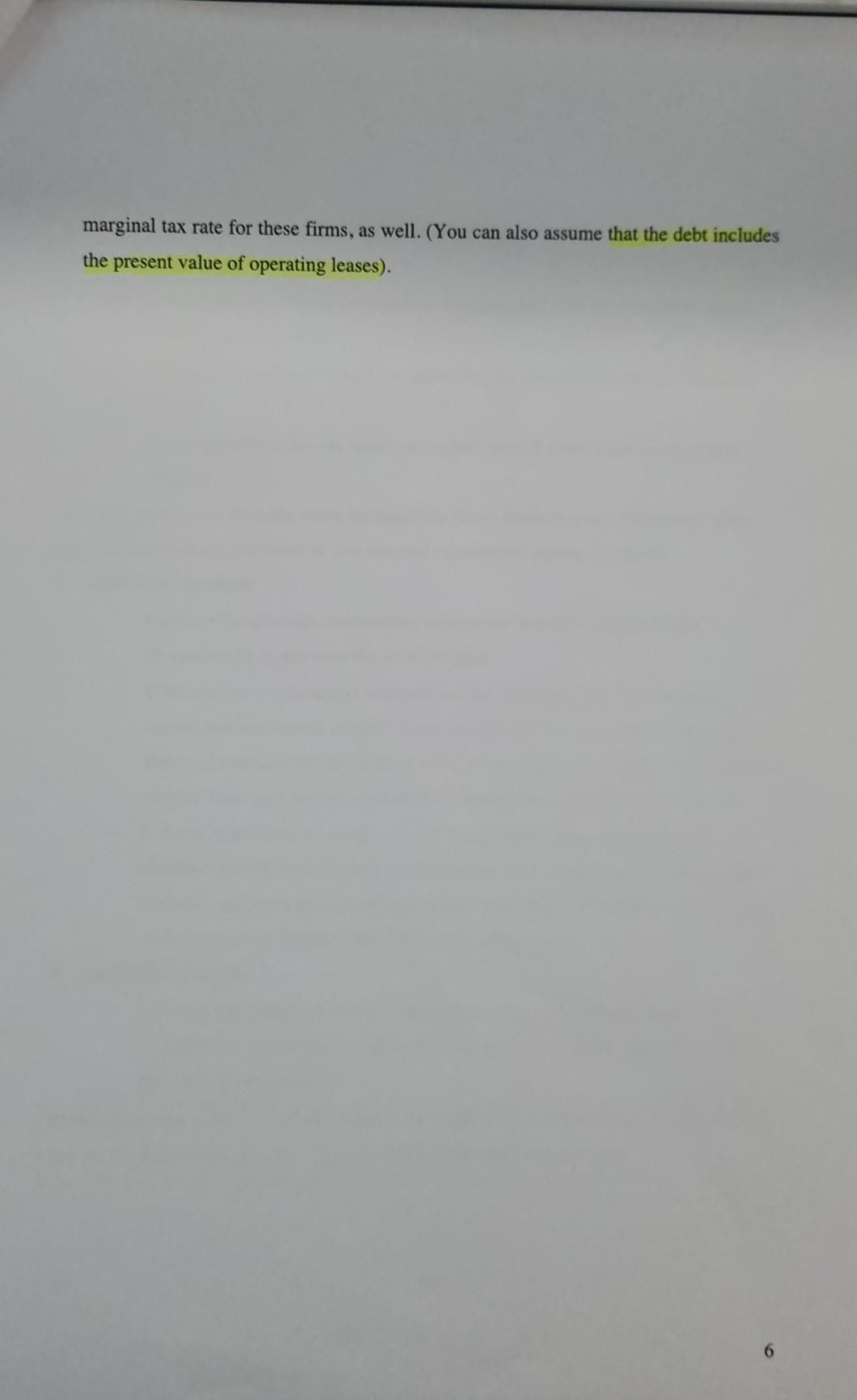
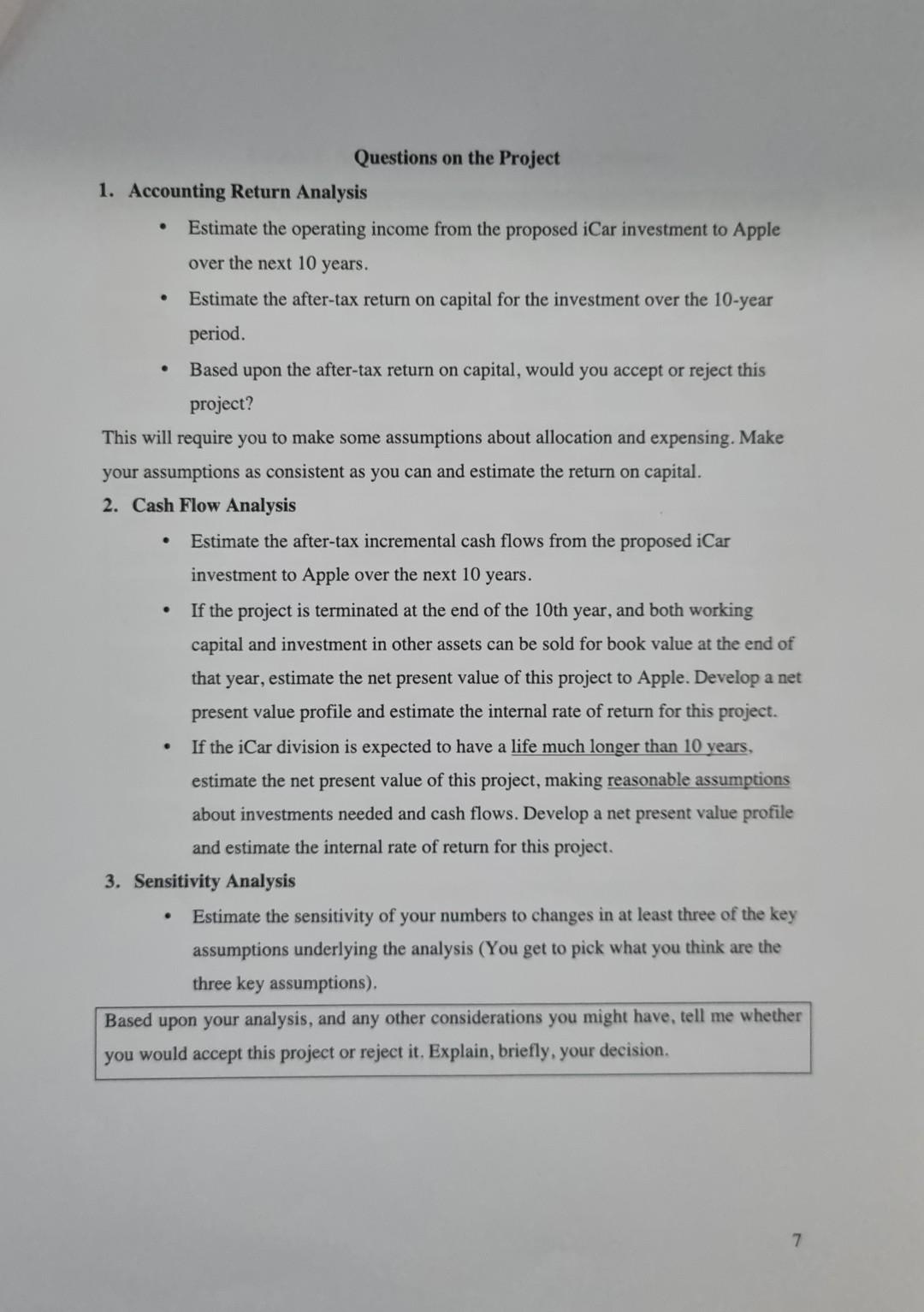
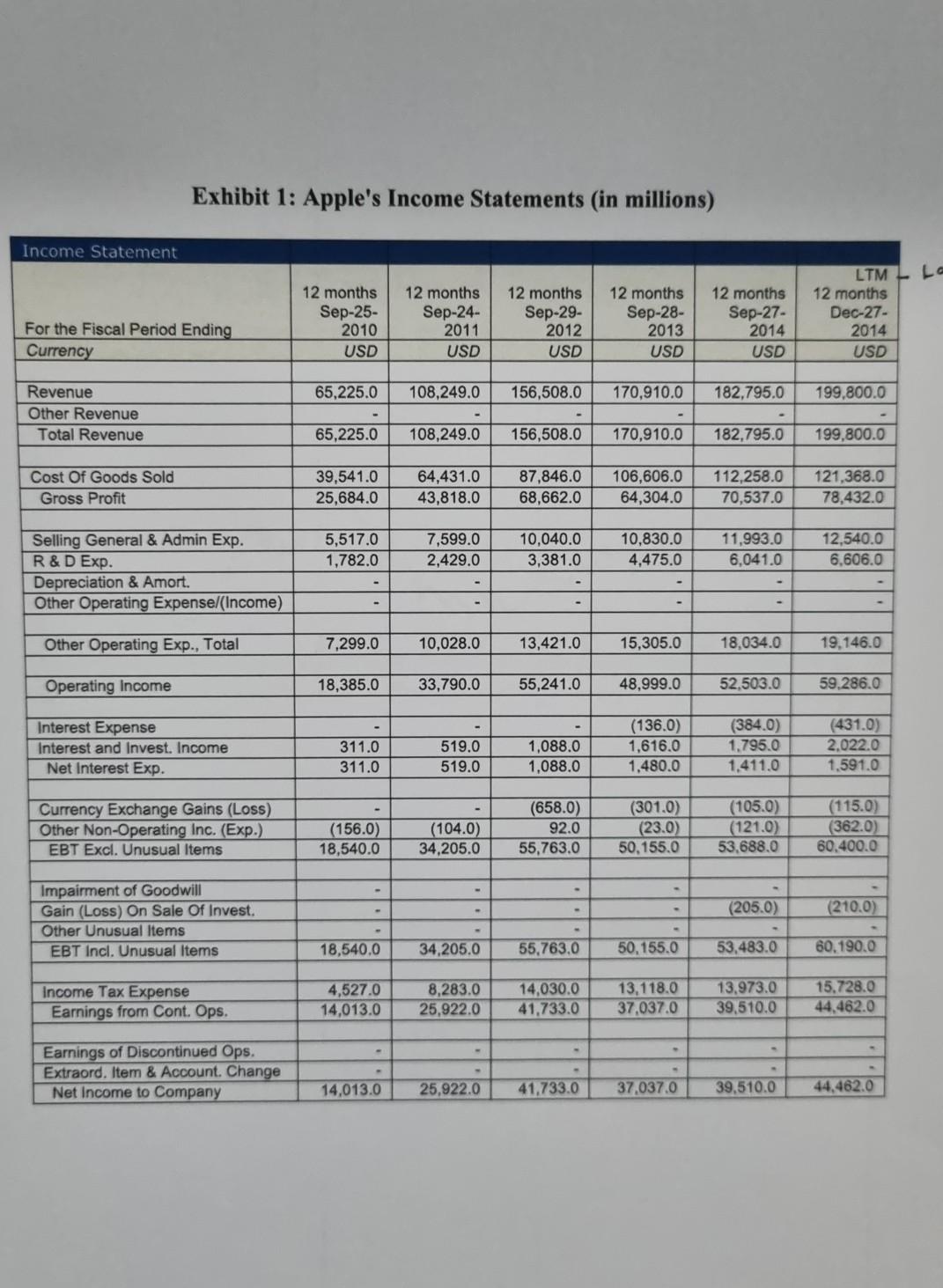
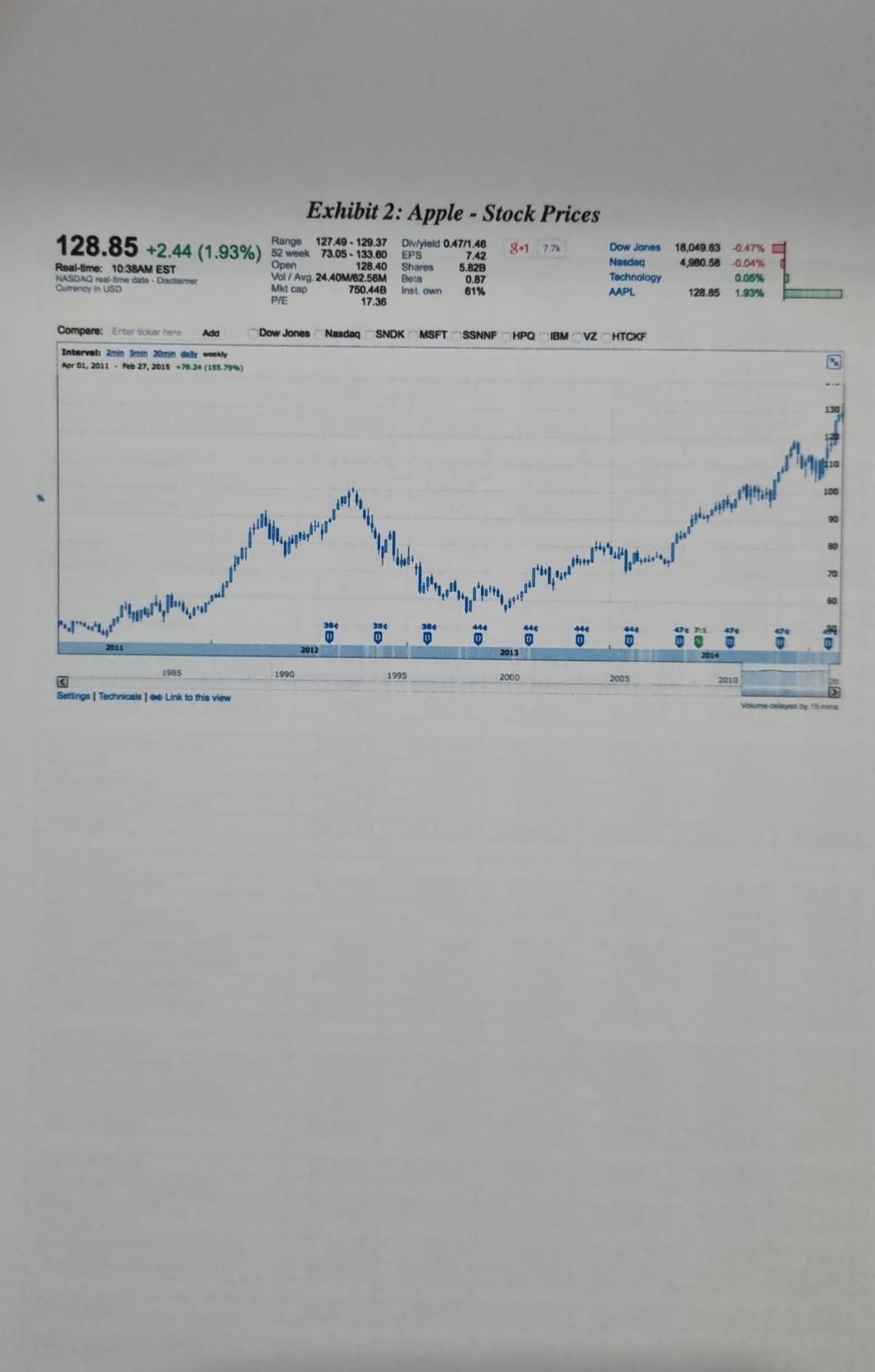
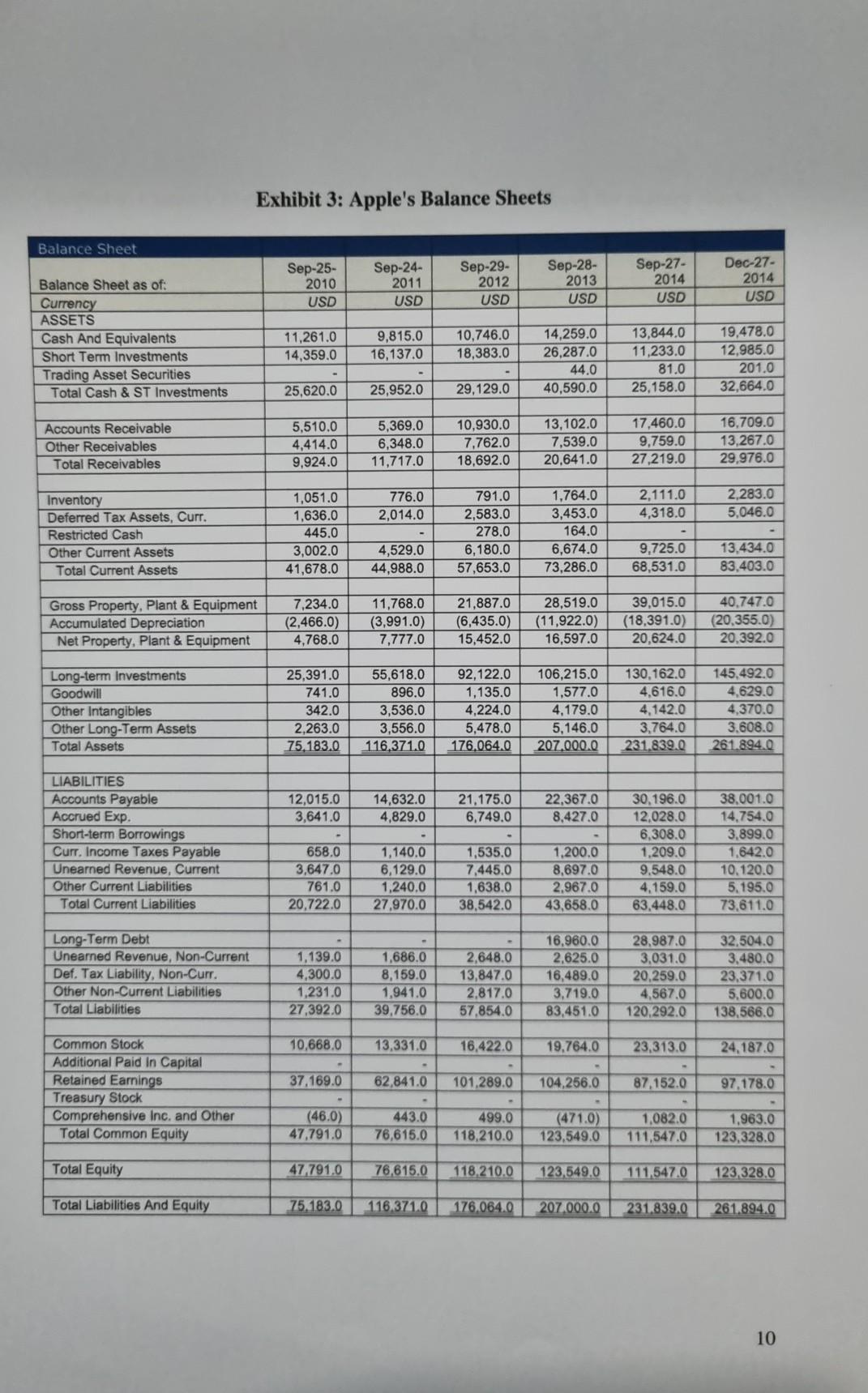
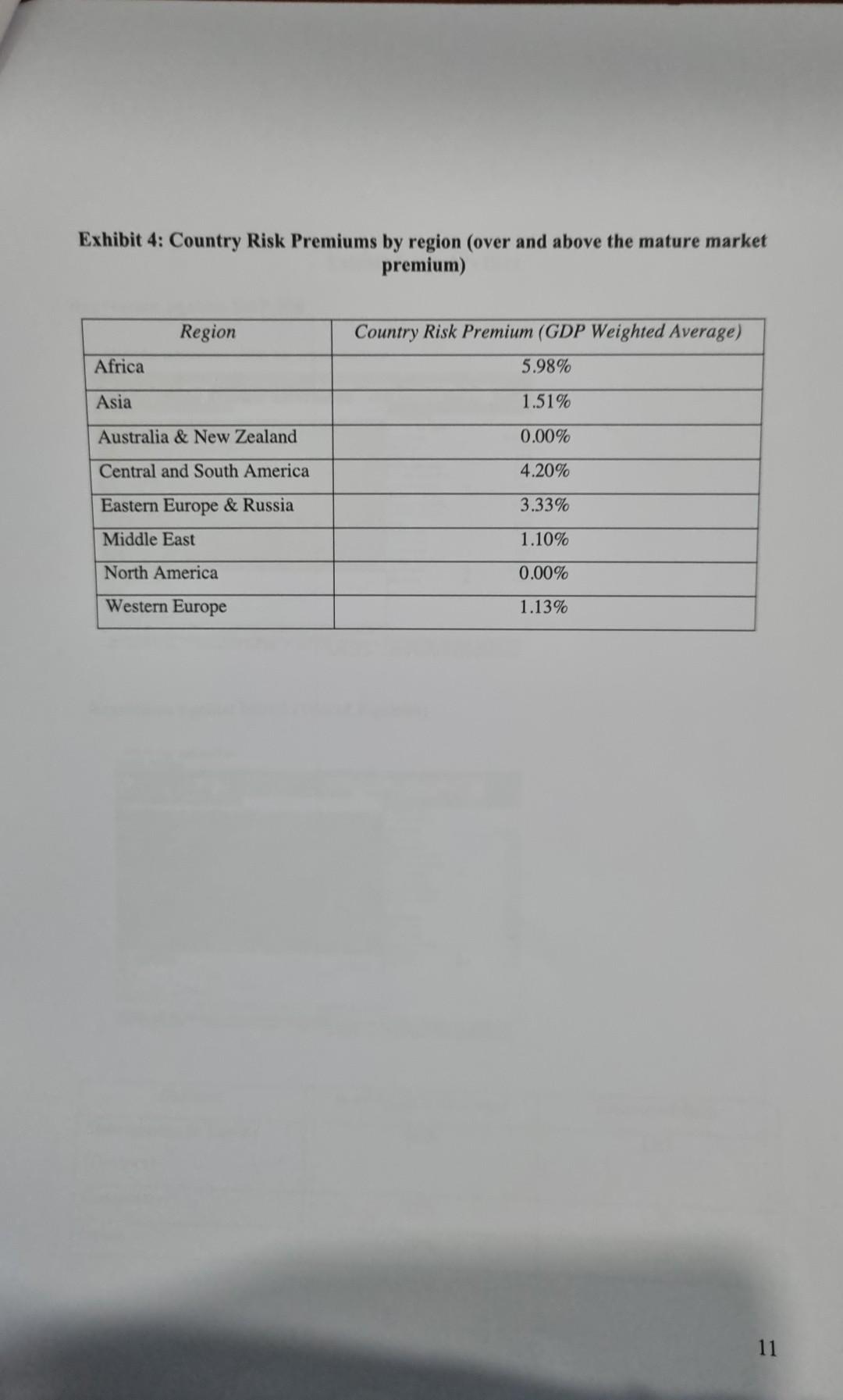
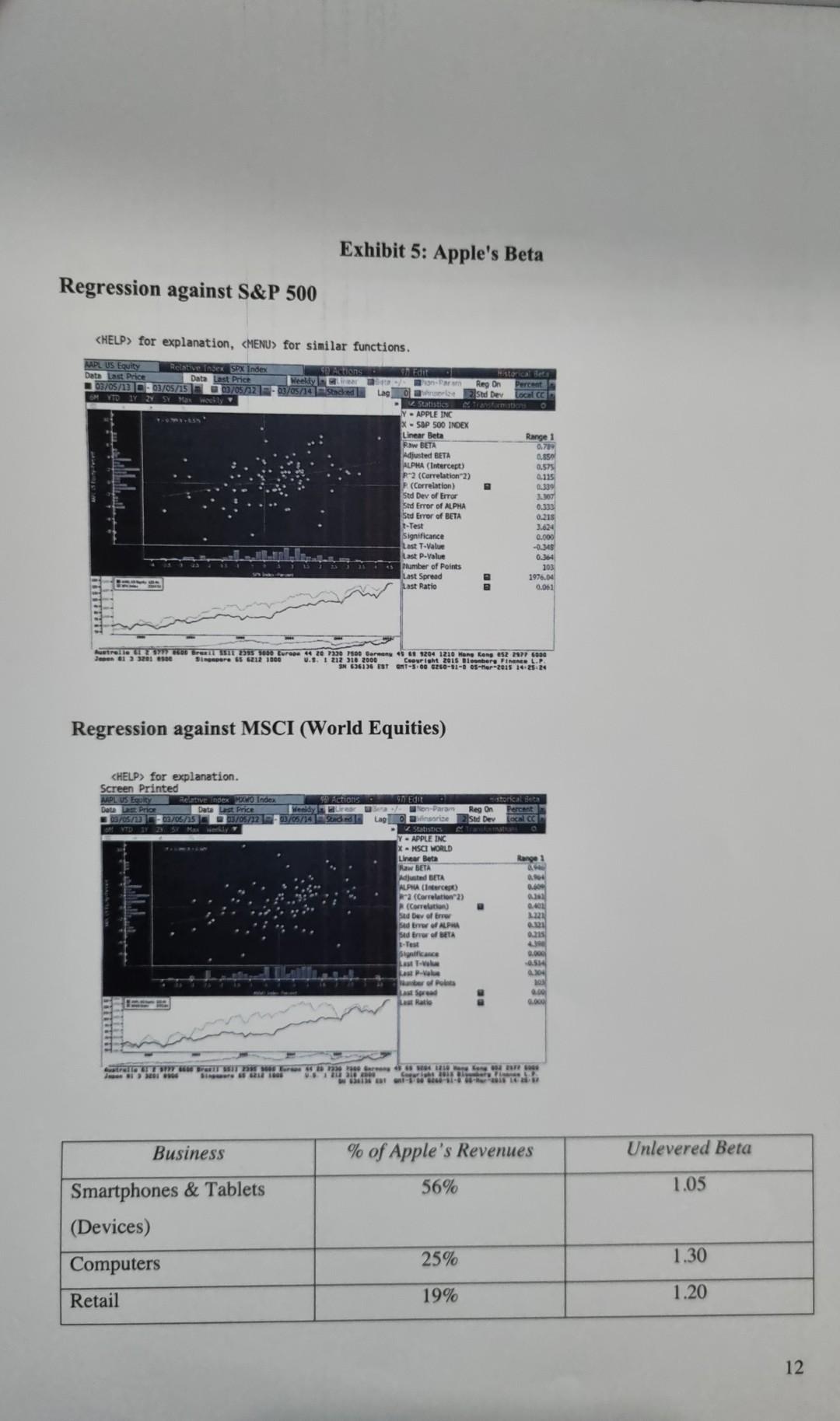
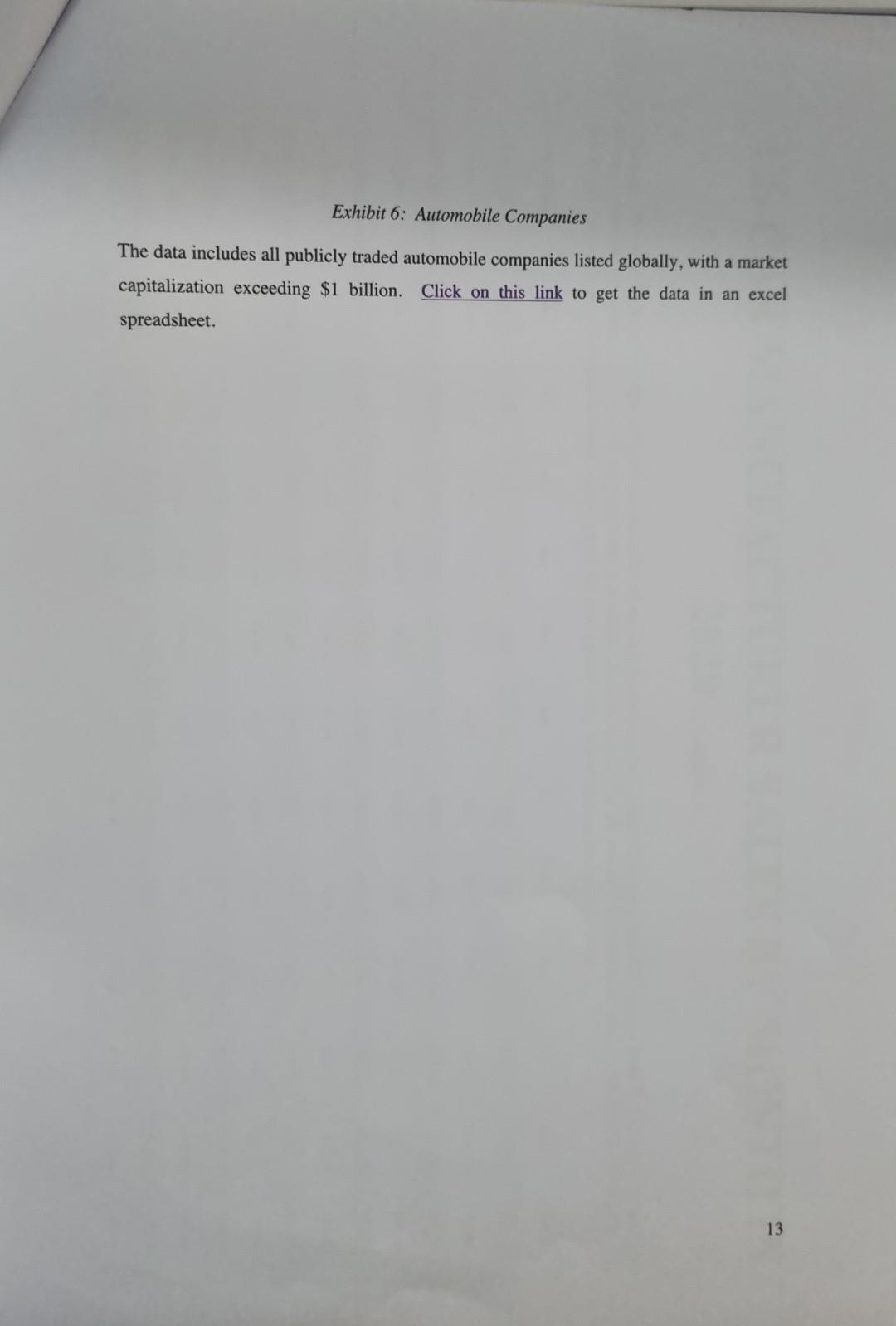
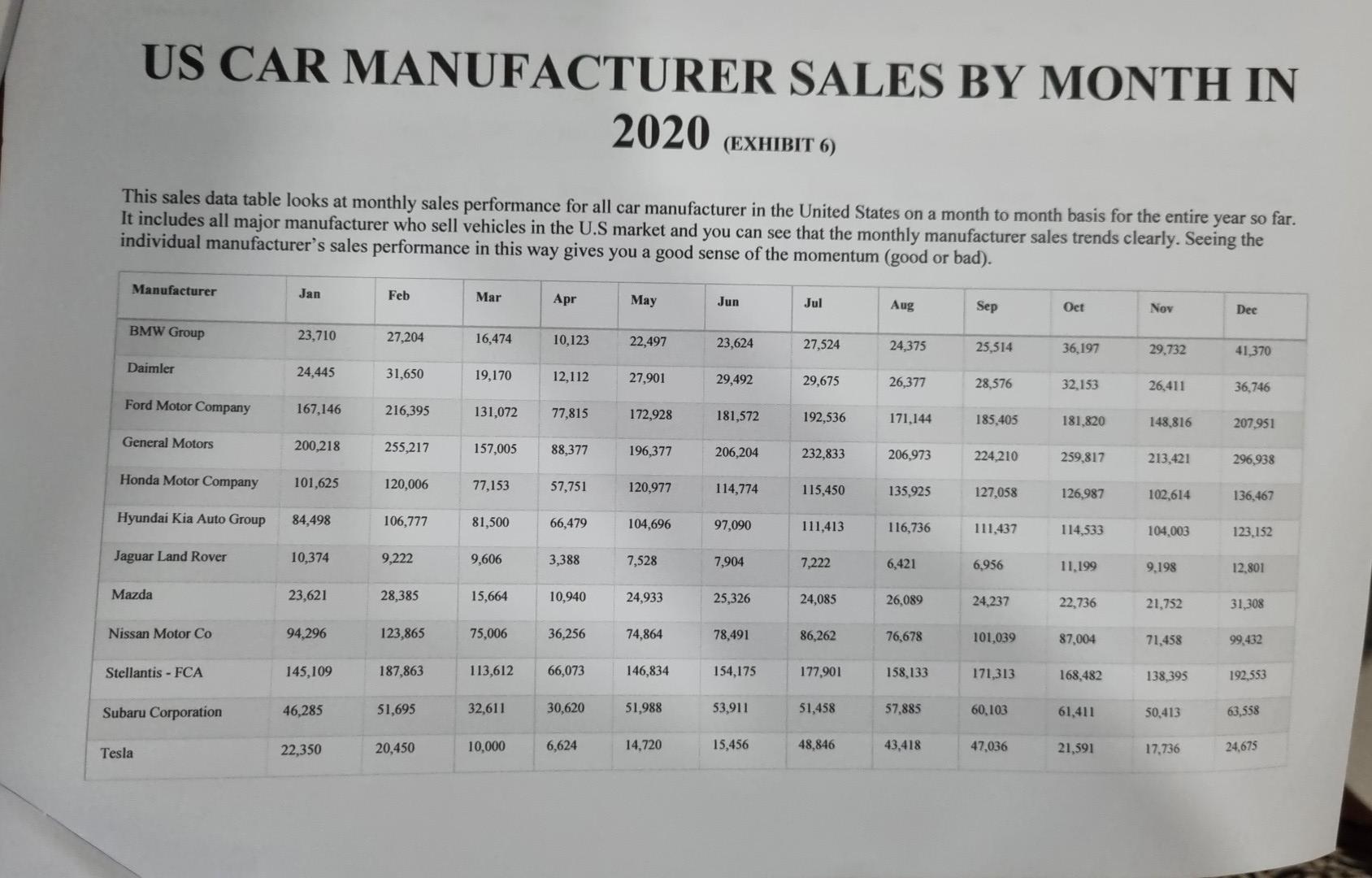
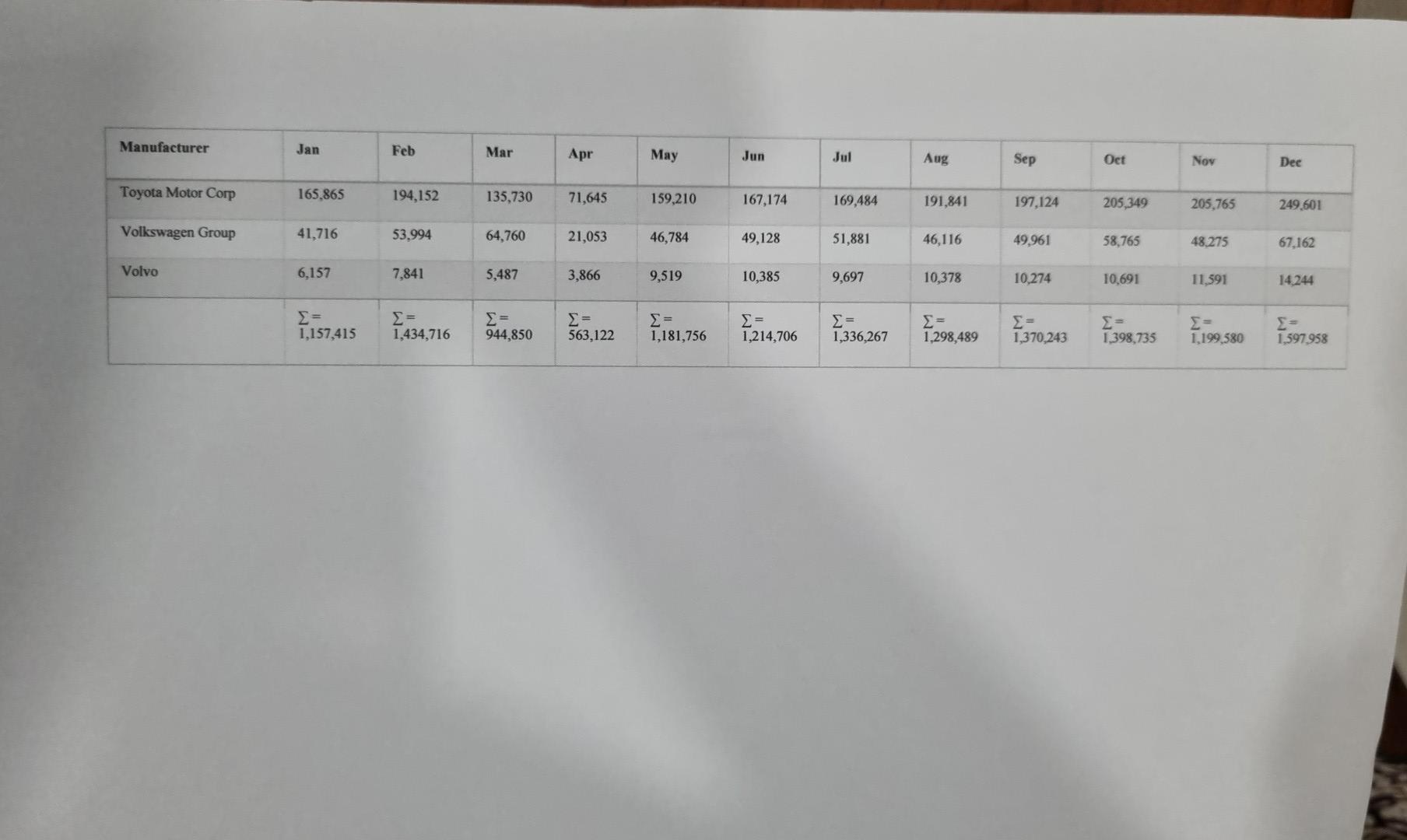
An Investment Analysis Case Study This case is a group project that is due on April 1, before class at 10.30. Stating the obvious: Each group will turn in one report (sounds obvious, but might as well make it explicit) electronically (as a pdf file). While you should include your flows tables in your report, you don't have to attach your excel spreadsheets. Cover page: Each report should have a cover page that contains following - the cash names of the group members in alphabetical order and the following summary information on the analysis: Decision on Investment: Invest or Do not invest Cost of capital: % value Return on capital: % value NPV - 10-year life: $ value NPV- Longer life: $ value Report format: Please try to keep your report brief. In the report, be clear about: a. Any assumptions you made to get to your conclusion b. Your final recommendation Exhibits: Please make sure that you include the following in your exhibits a. The table of earnings/cash flows by year b. Your computation of cost of equity/capital/discount rate Time: To keep time straight, you can assume the following: Next year: Year 1 Most recent year: Just ended Right now: Time 0. Any "up front" expenditure is incurred immediately. 1 Apple Disrupts the Auto Market: The Apple iCar? The Setting Apple Inc. has had a very good run, both in terms of earnings and stock prices, over the last decade. Based largely on the success of the iPod, the iPhone and the iPad, the company has reported double digit growth in revenues and earnings over the last few years (see exhibit 1) and its stock price has reflected this success (see exhibit 2). It has a substantial cash balance and a strong balance sheet (see exhibit 3 for balance sheet information). However, Tim Cook, CEO of Apple, is concerned that the halcyon days of the iPhone are coming to an end and is under pressure from financial markets to come up a new product in a big market. The Proposal Apple is considering entering the automobile market with an innovatively designed electric car, called the iCar, aimed at the premium end of the automobile market. You have been asked to collect the data to make the assessment and have come back with the following information: 1. R&D Expenses: Apple has already spent (and expensed) $ 5 billion on research on the automotive technology and development of the commercial design. None of that money can be recouped at this stage, if Apple decides not to go ahead with the iCar. 2. Introductory Costs; If Apple decides to go ahead with the iCar investment, it will have to spend $22 billion up front (right now) to lock in suppliers, distributors and retailers and to invest in infrastructure. The cost is depreciable over the next 10 years, down to a salvage value of $ 2 billion, and Apple expects to use straight-line depreciation 3, Market Potential and Share: In the premium auto market (including all cars priced at or above $60,000) there were 5 million automobiles sold globally in the most recent year and the market is expected to grow approximately 4% a year for the next decade. Apple expects to gain a 2% market share next year if the iCar is introduced and increase that market share by 2% a year (4% in the second year, 6% in the third year, 8% in the fourth year and 10% in year 5) to reach a target market share of 10% of the overall market by the fifth year. It expects to maintain that market share beyond year 6. 2 4. Pricing and Unit Costs: Apple expects to price its cars at $ 75,000 a unit next year and the price will keep pace with inflation after that. Based upon the costs of the the materials used in the iCar currently, Apple expects the production cost per unit to be $ 50,000 next year and grow at the inflation rate thereafter. 5. Marketing Options and Costs: Apple plans to use two different retailing options. In the first, it will sell the iCar through auto retailers and pay the retailers a commission of 10% of the price per unit sold (The retailers will have to follow Apple's fixed price schedule - no discounting allowed). In the second, it will sell the iCar through the Apple Auto Stores around the country. To do the latter, Apple will have to spend $5 billion right now in creating the stores; this expense will be depreciated straight line over the next 10 years to a salvage value of zero. It will also pay its sales people a commission of 5% of the price per unit for every car sold at an Apple Auto store. Apple expects to generate 80% of its revenues from specialty retailers and 20% from Apple Auto Store sales each year for the next 10 years. 6. Geographical breakdown: Apple expects to get its revenues from the iCar globally, with the following breakdown for revenues: Region % of Revenues Africa 2.00% Asia 30.00% Australia & New Zealand 8.00% Central and South America 10.00% Eastern Europe & Russia 5.00% Middle East 5.00% North America 25.00% Western Europe 15.00% Apple expects this revenue breakdown for the iCar to be stable over time. The regional country risk premiums (over and above the mature market premium) are provided in exhibit 4. You can assume that the premium for mature markets (Aaa rated countries) is 5.75%. 7. Production Facilities and Costs: Apple currently uses a manufacturing facility in Singapore to make batteries for its devices (iPhone, iPod and iPad). Apple used only 40% of the facility in the most recent year but the device market is expected to grow 12% a year for the next 10 years. If Apple goes ahead with the iCar, it will use the excess capacity to produce batteries for the iCar, with every 10,000 iCar batteries 3 using 1% of the capacity. (Thus, in a given year, if 200,000 iCars are produced, it will take up 20% of the total capacity of the battery factory). If the capacity limit is reached, Apple will have to invest a substantial amount to create a new facility of equivalent capacity. The current estimate of the cost of building a new facility is $ 5 billion, but this cost will grow at the inflation rate. 8. G&A expenses: Apple will allocate 10% of its existing general and administrative costs to the new division. These costs total $ 7.5 billion for the entire firm in the most recent year and are expected to grow 5% a year for the next 10 years, with or without the iCar investment. In addition, it is expected that Apple will have an increase of $ 0.5 billion in general and administrative costs next year when Apple iCar is introduced, and this amount will grow with the new division's dollar revenues after that. The latter cost is directly related to the new iCar division. 9. Advertising Expenses: Apple spent $ 8 billion on advertising in the most recent year. If Apple does not invest in the iCar, it expects this cost to increase 5% a year for the next 10 years. If the iCar is introduced, the total advertising expenses each year, from years 1 to 10, are expected to be 15% higher than they would have been without the iCar division. 10. Working Capital: The iCar will create working capital needs, which you have estimated as follows: . The sale of iCars to retailers will create accounts receivable amounting to 5% of revenues each year. Inventory (of both the input material and finished iCars) will be approximately 10% of the variable production cost (not including depreciation, marketing costs, allocations or advertising expenses). Accounts payable will be 6% of the variable production cost (not including depreciation, marketing costs, allocations or advertising expenses). All of these working capital investments will have to be made at the beginning of each year in which goods are sold. Thus, the working capital investment for the first year will have to be made at the beginning of the first year. 11. Side benefits for device sales: If Apple goes ahead with the Apple iCar, it will see revenues for the iPhone and iPad increase by $2 billion next year (as they are 4 integrated into the iCar), and grow at the inflation rate after that. The after-tax operating margin (after tax operating income/ revenues) is 40% for all Apple devices (iPads and iPhones). 12. Risk Measures: The beta for Apple is 0.79, calculated using weekly returns over the last 2 years and against the S&P 500 Index and 0.95 against the MSCI Global Index(see exhibit 5). Apple currently gets about 56% of its revenues from smartphones/tablets, 25% from computers and 19% from retail. The details of the beta calculation are included in Exhibit 5, as well as bottom up beta estimates for each of the three businesses of Apple. The current stock price for the firm is $ 128.85/share and there are 5,824.5 million shares outstanding. 13. Debt Choices: Apple expects to finance the iCar division using the same mix of debt and equity (in market value terms) as it is using currently in the rest of its business. Apple's currently has $36.4 billion in book value of interest bearing debt (with a weighted average maturity of 5 years) and it reports the following lease commitments for the future: Year Lease commitment 2015 $ 662 million 2016 $ 676 million 2017 $ 645 million 2018 $ 593 million 2019 $ 534 million Beyond $ 1,877 million The lease payment for the most recent year is $717 million. Apple was rated AA+ and the default spread for companies with that rating is 0.50%. 14. Taxes: Apple's effective tax rate is 26%, but its marginal tax rate is 40%. 15. Macro data: The current long-term US Treasury bond rate is 2.0%, and the expected inflation rate is 1.5%. 16. Other information: You have collected information on other automobile companies in Exhibit 6. The data includes the regression betas of these companies and relevant information on both market values of debt, equity and cash. You can assume a 40% 5 marginal tax rate for these firms, as well. (You can also assume that the debt includes the present value of operating leases). 6 Questions on the Project 1. Accounting Return Analysis . Estimate the operating income from the proposed iCar investment to Apple over the next 10 years. . Estimate the after-tax return on capital for the investment over the 10-year period. Based upon the after-tax return on capital, would you accept or reject this project? This will require you to make some assumptions about allocation and expensing. Make your assumptions as consistent as you can and estimate the return on capital. 2. Cash Flow Analysis . Estimate the after-tax incremental cash flows from the proposed iCar investment to Apple over the next 10 years. . If the project is terminated at the end of the 10th year, and both working capital and investment in other assets can be sold for book value at the end of that year, estimate the net present value of this project to Apple. Develop a net present value profile and estimate the internal rate of return for this project. . If the iCar division is expected to have a life much longer than 10 years, estimate the net present value of this project, making reasonable assumptions about investments needed and cash flows. Develop a net present value profile and estimate the internal rate of return for this project. 3. Sensitivity Analysis Estimate the sensitivity of your numbers to changes in at least three of the key assumptions underlying the analysis (You get to pick what you think are the three key assumptions), Based upon your analysis, and any other considerations you might have, tell me whether you would accept this project or reject it. Explain, briefly, your decision. 7 Exhibit 1: Apple's Income Statements in millions) Income Statement LTM LLC 12 months Sep-25- 2010 12 months Sep-24- 2011 For the Fiscal Period Ending Currency 12 months Sep-29- 2012 USD 12 months Sep-28- 2013 USD 12 months Sep-27- 2014 USD 12 months Dec-27- 2014 USD USD USD 65,225.0 108,249.0 156,508.0 170,910.0 182,795.0 199,800.0 Revenue Other Revenue Total Revenue 65,225.0 108,249.0 156,508.0 170,910.0 182,795.0 199,800.0 Cost Of Goods Sold Gross Profit 39,541.0 25,684.0 64,431.0 43,818.0 87,846.0 68,662.0 106,606.0 64,304.0 112,258.0 70,537.0 121,368.0 78,432.0 5,517.0 1,782.0 7,599.0 2,429.0 10,040.0 3,381.0 10,830.0 4,475.0 11,993.0 6,041.0 12,540.0 6.606.0 Selling General & Admin Exp. R & D Exp. Depreciation & Amort. Other Operating Expense/Income) Other Operating Exp., Total 7,299.0 10,028.0 13,421.0 15,305.0 18.034.0 19,146.0 Operating Income 18,385.0 33,790.0 55,241.0 48,999.0 52,503.0 59.286.0 Interest Expense Interest and Invest. Income Net Interest Exp. 311.0 311.0 519.0 519.0 1,088.0 1,088.0 (136.0) 1,616.0 1,480.0 (384.0) 1.795.0 1,411.0 (431.0) 2.022.0 1,591.0 Currency Exchange Gains (Loss) Other Non-Operating Inc. (Exp.) (156.0) 18,540.0 (104.0) 34,205.0 (658.0) 92.0 55,763.0 (301.0) (23.0) 50,155.0 (105.0) (121.0) 53,688.0 (115.0) (362.0) 60.400.0 EBT Excl. Unusual Items - (205.0) (210.0) Impairment of Goodwill Gain (Loss) On Sale Of Invest. Other Unusual Items EBT Incl. Unusual Items 18,540.0 34,205.0 55,763.0 50,155.0 53,483.0 60.190.0 Income Tax Expense Earnings from Cont. Ops. 4,527.0 14.013.0 8.283.0 25,922.0 14,030.0 41,733.0 13,118.0 37.037.0 13,973.0 39,510.0 15,728.0 44,462.0 Earnings of Discontinued Ops. Extraord. Item & Account Change Net Income to Company 14,013.0 25,922.0 41,733.0 37.037.0 39,510.0 44,462.0 Exhibit 2: Apple - Stock Prices 128.85 +2.44 (1.93%) s2 week 73.05 - 18.00 8-1 774 Real-time: 10:38AM EST NASDAQ-time data - Didier Currency in USD Range 127.49 - 129.37 Diviyield 0.4771.46 EPS 7.42 Open 128.40 Shares 5.82B Vol / Avg 24.40M/62.56M Bela 0.87 Mkt cap 750.44B Inst. own 61% P/E Dow Jones Nasdaq Technology AAPL 18,049.63 0.47% 4.980.58 0.04% 0.06% 128.85 1.93% 17.36 Compare: Enter tickar here Add Dow Jones Nasdaq SNDK MSFT SSNNF HPQ IBM VZ HTCKF Interval: 2min Smin 30min a weekly Apr 01, 2011 Feb 27, 2015 +7.24 (155.791) 130 petrolhealthy houl 384 446 444 440 47 470 D 0 US U 2011 2012 2013 2014 1985 1990 1995 2000 2005 2010 Settings Technicas e Link to this view Volume Exhibit 3: Apple's Balance Sheets Balance Sheet Sep-25- 2010 USD Sep-24- 2011 USD Sep-29- 2012 USD Sep-28- 2013 Sep-27- 2014 USD Dec-27- 2014 USD USD Balance Sheet as of: Currency ASSETS Cash And Equivalents Short Term Investments Trading Asset Securities Total Cash & ST Investments 11,261.0 14,359.0 9,815.0 16,137.0 10,746.0 18,383.0 14,259.0 26,287.0 44.0 40,590.0 13,844.0 11,233.0 81.0 25,158.0 19,478.0 12,985.0 201.0 32,664.0 25,620.0 25,952.0 29,129.0 Accounts Receivable Other Receivables Total Receivables 5,510.0 4,414.0 9,924.0 5,369.0 6,348.0 11.717.0 10,930.0 7,762.0 18,692.0 13,102.0 7,539.0 20,641.0 17,460.0 9,759.0 27,219.0 16,709.0 13,267.0 29,976.0 776.0 2,014.0 2,111.0 4,318.0 2.283.0 5,046.0 Inventory Deferred Tax Assets, Curr. Restricted Cash Other Current Assets Total Current Assets 1,051.0 1,636.0 445.0 3,002.0 41,678.0 791.0 2,583.0 278.0 6,180.0 57,653.0 1,764.0 3,453.0 164.0 6,674.0 73,286.0 4,529.0 44,988.0 9,725.0 68,531.0 13.434.0 83,403.0 Gross Property, Plant & Equipment Accumulated Depreciation Net Property, Plant & Equipment 7,234.0 (2,466.0) 4,768.0 11.768.0 (3,991.0) 7,777.0 21,887.0 (6,435.0) 15,452.0 28,519.0 (11,922.0) 16,597.0 39,015.0 (18,391.0) 20,624.0 40.747.0 (20,355.0) 20,392.0 Long-term Investments Goodwill Other Intangibles Other Long-Term Assets Total Assets 25,391.0 741.0 342.0 2,263.0 75.183.0 55,618.0 896.0 3,536.0 3,556.0 116,371.0 92,122.0 1,135.0 4,224.0 5,478.0 176,064.0 106,215.0 1,577.0 4,179.0 5,146.0 207.000.0 130,162.0 4.616.0 4,142.0 3,764.0 231.839.0 145,492.0 4,629.0 4,370.0 3.608.0 261.894.0 12,015.0 3,641.0 14,632.0 4,829.0 21,175.0 6,749.0 22,367.0 8,427.0 LIABILITIES Accounts Payable Accrued Exp. Short-term Borrowings Curr. Income Taxes Payable Unearned Revenue, Current Other Current Liabilities Total Current Liabilities 658.0 3,647.0 761.0 20,722.0 1,140.0 6,129.0 1,240.0 27,970.0 1,535.0 7,445.0 1,638.0 38,542.0 1.200.0 8,697.0 2,967.0 43,658.0 30.196.0 12,028.0 6,308.0 1,209.0 9.548.0 4,159.0 63,448.0 38.001.0 14,754.0 3,899.0 1,642.0 10.120.0 5.195.0 73,611.0 Long-Term Debt Unearned Revenue, Non-Current Def. Tax Liability, Non-Curr. Other Non-Current Liabilities Total Liabilities 1,139.0 4,300.0 1,231.0 27,392.0 1,686.0 8,159.0 1,941.0 39,756.0 2,648.0 13,847.0 2.817.0 57,854.0 16,960.0 2.625.0 16,489.0 3,719.0 83,451.0 28,987.0 3,031.0 20.259.0 4,567.0 120.292.0 32,504.0 3,480.0 23,371.0 5,600.0 138,566.0 10,668.0 13,331.0 16,422.0 19,764.0 23,313.0 24,187,0 37,169.0 62,841.0 101,289.0 104,256.0 87,152.0 Common Stock Additional Paid In Capital Retained Earnings Treasury Stock Comprehensive Inc. and Other Total Common Equity 97,178.0 (46.0) 47,791.0 443.0 76,615.0 499.0 118,210.0 (471.0) 123,549.0 1,082.0 111,547.0 1,963.0 123,328.0 Total Equity 47 791.0 76,615.0 118,210.0 123,549.0 111,547.0 123,328.0 Total Liabilities And Equity 75.183.0 116.371.0 176.064.0 207.000,0 231.839.0 261.894.0 10 Exhibit 4: Country Risk Premiums by region (over and above the mature market premium) Region Country Risk Premium (GDP Weighted Average) Africa 5.98% Asia 1.51% Australia & New Zealand 0.00% Central and South America 4.20% Eastern Europe & Russia 3.33% Middle East 1.10% North America 0.00% Western Europe 1.13% 11 Exhibit 5: Apple's Beta Regression against S&P 500
for explanation,





















